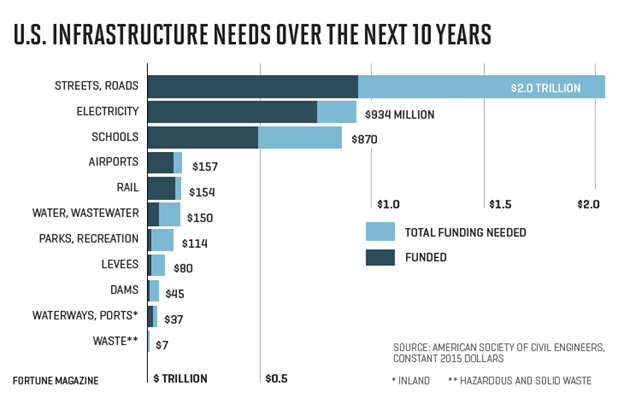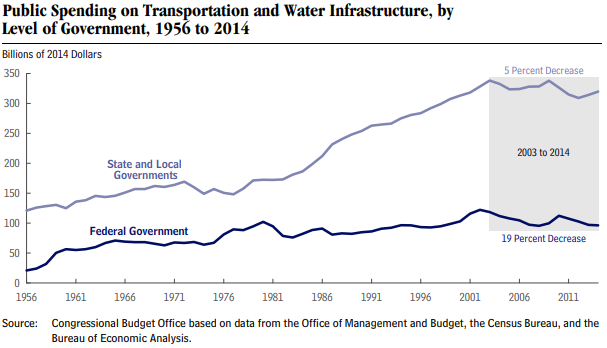Biden’s massive infrastructure plan might be expensive but well worth it
Politics / Infrastructure Mar 11, 2021 - 02:46 PM GMTBy: Richard_Mills
Is America’s infrastructure spending worth it? So far, the answer would lean towards a yes.
A report published by the American Society of Civil Engineers (ASCE) this week has validated the nation’s recent success in improving its infrastructure, while justifying the need for additional government spending.
The “Report Card for America’s Infrastructure”, published every four years since 1998, gave US infrastructure an average grade of “C-” — up from a “D+” in 2017 — marking the first time in two decades that a “C” range grade was given.
While it appears the US infrastructure programs are on the right track, a lot more work still needs to be done to address those crumbling roads and bridges, says the ASCE, labelling overall US infrastructure in “mediocre condition.”
More Spending
The road to upgrading America’s infrastructure is a long and costly one.
According to the engineering society, the US is paying just about half of its infrastructure bill, and its total investment gap has in fact widened over the past decade. The country is now facing a $2.59 trillion shortfall in infrastructure needs over the next 10 years that will require a massive jump in investment, the ASCE says.

The ASCE study graded a total of 17 categories of infrastructure, ranging from a “B” for rail to a “D-” for transit. Five category grades (aviation, drinking water, energy, inland waterways and ports) went up, while only one category (bridges) went down. The remaining 11 categories received “D” range grades, signaling room for improvement.
Casey Dinges, senior managing director at the ASCE, estimates that it will take $200 billion in spending every year for 10 years, from any combination of public and private sources, to get America’s infrastructure to a “B” grade range.
The biggest projected spending gap is in surface transportation, with a total of $1.2 trillion in unmet needs over the next 10 years. The next largest funding gaps are in the water systems and schools, which require $434 billion and $380 billion, respectively.
As a result, the engineering society has urged the US to bolster investment from all levels of government and the private sector to 3.5% from 2.5% of its GDP by 2025.
“We risk significant economic losses, higher costs to consumers, businesses and manufacturers – and our quality of life – if we don’t act urgently,” ASCE Executive Director Thomas Smith said in a statement.
The massive power outages that happened recently in Texas served as a timely reminder that America’s infrastructure can be frail even in one of the biggest states.
One industry expert even went as far as to say that “America’s infrastructure was basically built in the past 100 years, along with projects following World War II.”
Without a significant infrastructure hike, by 2039 the US economy will lose $10 trillion in growth, exports will decline by $2.4 trillion and 3 million jobs will be lost, the ASCE warns.
Biden’s Pitch
Whether the Society’s call for more investment will be answered remains to be seen, but it would add more ammunition for President Joe Biden’s lobby for a dramatic jump in infrastructure spending over the coming weeks.
Long before the ASCE report card, Biden, along with the Democratic-run House and Senate, has been planning for a massive, longer-term infrastructure spending spree after the covid aid package is enacted.
Under his “Build Back Better” plan, Biden previously campaigned to spend over $7 trillion on initiatives, with US infrastructure being the centerpiece. These include a big jump in spending on surface transportation, airports, transit systems, as well as addressing high-speed broadband, electrical grids and water systems and boosting electric vehicles charging and high-speed rail.
Biden’s latest infrastructure spending bill, drawn on the “Build Back Better” proposals, has the support of both parties, but is facing pushback and skepticism from bipartisan groups.
A meeting is scheduled this week between the President and bipartisan lawmakers to discuss those spending plans, from which Biden is hoping to win funding approval for his ambitious infrastructure plan after seeing his predecessors Donald Trump and Barack Obama fail to do so.
Transportation Secretary Pete Buttigieg, also part of this meeting, is all-in on rebuilding the nation’s aging roads, dams and railroads.
The former mayor of South Bend, Indiana, stated that the ASCE report documents “what Americans already know: failure to fully invest in our infrastructure over the years is now catching up to us. Consequences are appearing nationwide, in the form of dangerously degraded roads, bridges and other assets.”
“We are so far behind the curve,” Biden said last month ahead of a meeting with labor leaders. “We rank something like 38th in the world in terms of our infrastructure — everything from canals to highways to airports.”
The President added that the US needs to do “everything we can do…to make ourselves competitive in the 21st century.”
Tax Options
Just how will Biden and the Congress fund any new infrastructure spending is up in the air, and his administration has not revealed the text of its infrastructure package yet.
The last time the federal government raised the gas tax, which is supposed to fund improvements to US highways, was back in 1993. However, Buttigieg told Bloomberg in a recent interview that raising the gas tax was “off the table.”
So, this time around, the tax burden may be placed on the wealthy and corporations, an idea that is being floated around by Democrats.
Regardless of details and the price tag, Biden’s infrastructure bill must obtain the necessary backing of Republicans, which have already opposed his plans to curb carbon emissions.
The party “won’t support another Green New Deal disguising itself as a transportation bill,” said Representative Sam Graves of Missouri, the senior Republican on the Transportation Committee, adding that there is a growing disparity between resources devoted to urban and rural infrastructure that still needs to be addressed.
“Republicans are eager to work on bipartisan solutions, but it will take a willingness to compromise and a good faith effort to consider Republican priorities,” Graves said.
State and local governments, however, have been doing their part. Since 2010, as many as 37 US states have raised gas taxes to fund transportation, and voters approved 98% of local infrastructure ballot initiatives in November.

“The states can’t go it alone. The cities cannot go it alone. They need a federal partner,” Peter DeFazio, chairman of the House Transportation committee and Oregon Democrat, urged earlier. DeFazio, one of the eight lawmakers attending this week’s meeting, previously helped to pass the $1.5 trillion infrastructure package in 2020 that hit a brick wall in the Senate.
New Economic Hires
As Biden prepares to lobby for his second major spending bill, the White House has welcomed two transportation and manufacturing specialists to its senior ranks.
The addition of Elisabeth Reynolds, a manufacturing and economic development researcher at MIT, and Samantha Silverberg, a former top administrator at the transit authority in the greater Boston area, to the National Economic Council signals Biden’s intent to fulfill his infrastructure goals during the early days of his administration.
Reynolds has studied topics including growing the domestic manufacturing base, while Silverberg previously led the development of an $8 billion transit upgrade program at the Massachusetts Bay Transportation Authority.
Implications
Goldman Sachs analysts recently said they expect Biden’s proposal to be worth at least $2 trillion — and potentially even double that — over the next 10 years; this figure is even higher than the economic relief bill.
To fund that much expenditure, they are expecting private sector tax increases on at least some of the proposed initiatives, which could offset up to about $1 trillion of the total cost of the final package.
But the spending could be well worth it, according to Bank of America, which forecast that this plan, should it get passed, would boost short-term US GDP by 2-9%. The long-run impact would be “considerably more,” the bank says.
The bank also predicts that the biggest beneficiaries would be industrial and materials firms, who will be called upon for these future infrastructure projects. It is estimated that each 1% move in GDP growth should translate into a 3-4% growth in the earnings of S&P 500 companies.
Small-cap businesses, whose sales tend to boom during periods of increased capital expenditure, will stand to gain as well.
An injection of funds towards “picks and shovels” industries would also represent a pivot from the largely tech-focused spending of late, which could even signify a change in market leadership, paving the way for the energy sector.
By Richard (Rick) Mills
If you're interested in learning more about the junior resource and bio-med sectors please come and visit us at www.aheadoftheherd.com Site membership is free. No credit card or personal information is asked for.
Richard is host of Aheadoftheherd.com and invests in the junior resource sector. His articles have been published on over 400 websites, including: Wall Street Journal, Market Oracle, USAToday, National Post, Stockhouse, Lewrockwell, Pinnacledigest, Uranium Miner, Beforeitsnews, SeekingAlpha, MontrealGazette, Casey Research, 24hgold, Vancouver Sun, CBSnews, SilverBearCafe, Infomine, Huffington Post, Mineweb, 321Gold, Kitco, Gold-Eagle, The Gold/Energy Reports, Calgary Herald, Resource Investor, Mining.com, Forbes, FNArena, Uraniumseek, Financial Sense, Goldseek, Dallasnews, Vantagewire, Resourceclips and the Association of Mining Analysts.
Copyright © 2021 Richard (Rick) Mills - All Rights Reserved
Legal Notice / Disclaimer: This document is not and should not be construed as an offer to sell or the solicitation of an offer to purchase or subscribe for any investment. Richard Mills has based this document on information obtained from sources he believes to be reliable but which has not been independently verified; Richard Mills makes no guarantee, representation or warranty and accepts no responsibility or liability as to its accuracy or completeness. Expressions of opinion are those of Richard Mills only and are subject to change without notice. Richard Mills assumes no warranty, liability or guarantee for the current relevance, correctness or completeness of any information provided within this Report and will not be held liable for the consequence of reliance upon any opinion or statement contained herein or any omission. Furthermore, I, Richard Mills, assume no liability for any direct or indirect loss or damage or, in particular, for lost profit, which you may incur as a result of the use and existence of the information provided within this Report.
© 2005-2022 http://www.MarketOracle.co.uk - The Market Oracle is a FREE Daily Financial Markets Analysis & Forecasting online publication.



